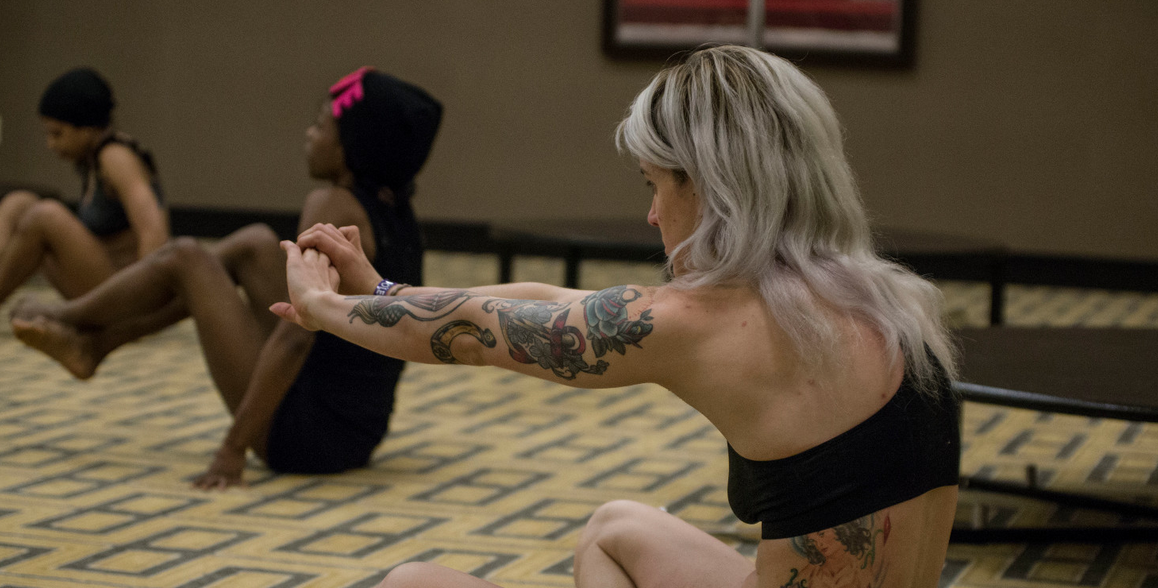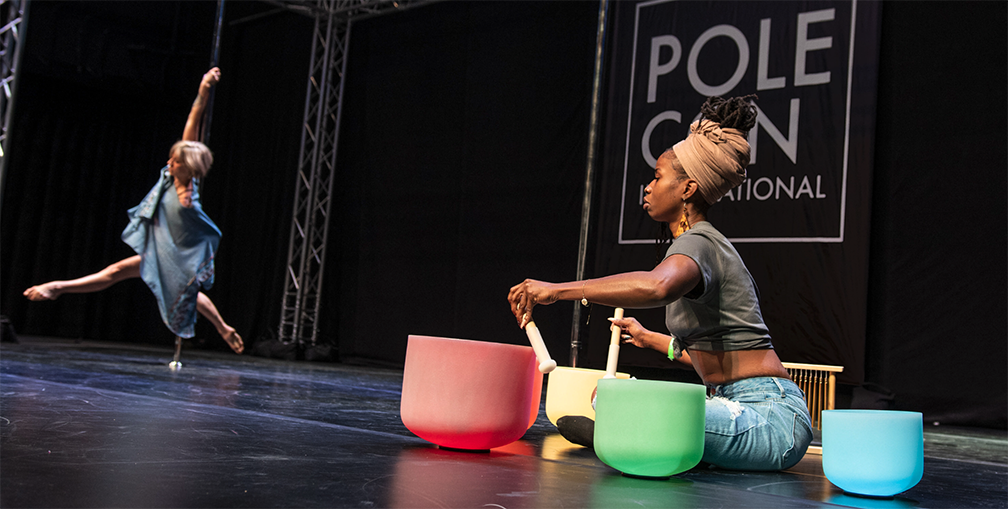Thank you to everyone who took our survey! We read every response. <3 *this is…

What is interoception?
Interoception is understanding what our body feels like on the inside.
The goal to developing a good sense of interoception from a movement perspective is to identify and categorize sensations in our body accurately so we can learn to understand how our body feels when it moves and to understand how to categorize sensations. This may include understanding the difference between pain and soreness sensations or to know when our body is ready for rest or when it is primed for action. This is what your instructor means when they say, “listen to your body.” Most of us, especially those of us coming to movement after injury or later in life, do not have a clear connection between our mind and body and this cue is often misunderstood or frankly ignored because it doesn’t make sense! Not understanding how our body is feeling however, can cause us to confuse a pain signal or can limit understanding what is happening in our body. If you’ve ever tried to learn a new movement and your instructor has had to tell you several times to “engage” or “squeeze” the same body part you may need help developing your interoception.
How the body gets along with and without us paying attention
Our bodies and brains are amazing, and many bodily functions happen without us having to consciously get involved. We do this using the autonomic nervous system. This system is largely unconscious and regulates functions like heart rate, digestion and more. When we sleep at night, our body is still alive when we way up, having done a myriad of functions successfully while we were “off the clock.”
The autonomic nervous system is broken into three parts which monitor our environment for and provide inputs to the rest of our body, telling it in an instant, how to react in a coordinated way. To simplify this complex system:
- The sympathetic nervous system prepares us for action.
- The parasympathetic nervous system prepares us to rest.
- The enteric nervous system connects our central nervous system to our gut and is sometimes called our “second brain” or our “gut brain” which can coordinate action or rest and is tied closely to our emotional response and our perception of intuition. All these systems work together to keep us moving safely through life.
Any input we receive from any of our senses may evoke a sensation response in our body including a pain response.
The rest of our bodily functions and the way that we interact every day with our movement, involve a combination of voluntary and involuntary or habitual responses. Some movements we do completely out of habit without any thought such as we walk, how we roll out of bed in the morning or even how we type—we may have learned these movements a long time ago and now they come easily to us. Other movements, especially those that we do for the first time, require intense thought and effort such as watching an instructor demonstrate a movement while listening to their verbal cues. Then we must process how to make our body mimic that movement giving our brain those inputs from our eyes and our ears to then send to the rest of the body. For those of us coming to movement later in life, after an injury, after a body changing experience, or even just learning something for the very first time, it can be extremely challenging to make these connections.
Understanding what your body is feeling on the inside is the first step to developing a path forward for how to improve your movement.
Even before an assessment phase of any kind, you need to identify the method and tools you’re using to do the assessment AND you need to understand what you are assessing. In this case, you are assessing your body and the connection from your body to your mind, using interoception as the method. There are many tools you can use to begin this connection to your body, several are listed in “Activities.”
Interoception Improvement Activities
Read each of these descriptions and try the one or ones that you feel most interested by. Continue practicing these activities regularly, possibly as part of a warmup or cool-down in your current movement routine until you can comfortable and accurately start to identify sensations in body parts and how those sensations make you feel. This will help you develop a greater connection to your body and improve communication between body and mind. It may also help with anxiety or relaxation.
Meditation is one way to learn interoception.
There are many different practices and options that all involve limiting stimulus (such as closing your eyes, sitting in a comfortable and safe position where you won’t be disturbed) and trying to turn your attention inwards. If this is something of interest to you, start or continue a meditation practice paying special attention to sensations in your physical body.
Body scanning is another way to develop interoception.
Sit in a comfortable position with your eyes closed. Take a few deep breaths.
Beginning at the top of your head, address each body part individually. Consider how your head is feeling. Are your eyes tired or dry? Is your mouth tight? Can you breathe easily through your nose or are you breathing through your mouth? Can you relax the muscles in your jaw? Move down to your neck, is your neck tight or constricted in any way? Continue moving throughout your body and begin to create a communications path between your mind and your different body parts. Begin to develop your own baseline for feeling “ok” or “functional” and take note of anything that falls below that baseline or is high above it. Maybe your feet feel fine, but your neck is very tight, and you don’t notice anything out of the ordinary in your belly.
Using emotional cues.
Some people respond more intensely to negative feelings than positive feelings and can begin to identify physical reactions and make connections to their body by using emotional stimuli. Read both negative and positive exercise options and choose which is best for you. The goal is to start to listen to your body, not to overwhelm yourself with emotion.
Using negative emotional cues:
Sit in a comfortable position with your eyes closed. Take a few deep breaths. Focus on something ordinary in your life that doesn’t typically elicit an emotional response such as the color of your carpet for 1 minute. It’s ok to let your mind wander. Try to find a neutral emotional state while maintaining a comfortable body position.
Note how your body feels:
- Do you feel any different from when you first sat down?
- Is your body constricted in any way? Did your breathing change? Do you feel sensations in specific parts of your body?
Now think of a time when you felt uncomfortable, anxious, or nervous for 1 minute.
Note how your body feels:
- Do you feel any different from when you first sat down?
- Is your body constricted in any way? Did your breathing change? Do you feel sensations in specific parts of your body?
Using positive emotional cues:
If practicing both the negative and the positive options, wait several hours between switching between the two to allow your body to completely reset.
Sit in a comfortable position with your eyes closed. Take a few deep breaths. Focus on something ordinary in your life that doesn’t typically elicit an emotional response such as the color of your carpet for 1 minute. It’s ok to let your mind wander. Try to find a neutral emotional state while maintaining a comfortable body position.
Note how your body feels:
- Do you feel any different from when you first sat down?
- Is your body constricted in any way? Did your breathing change? Do you feel sensations in specific parts of your body?
Now think of a time when you felt safe and comforted for 2 minutes.
Note how your body feels:
- Do you feel any different from when you first sat down?
- Is your body constricted in any way? Did your breathing change? Do you feel sensations in specific parts of your body?
Biofeedback is a term with many definitions.
At its most basic, it involves receiving feedback from your body by using other parts of your body to create a conscious connection to your mind.
- Sit in a comfortable position.
- Think about your butt.
- Try to feel the chair, floor, or other body parts under your bum.
- Now, try to squeeze your butt cheeks.
- Take a finger and firmly poke one of your butt cheeks.
- Try to squeeze the muscle of that butt cheek and press back at your finger.
- Keep poking and attempting to squeeze your butt cheek.
- Try your other cheek.
- Once you’ve found your butt muscles, try to squeeze them without poking them.
- Feel your butt moving gently on the floor.
- Try to squeeze one cheek at a time.
- Stand up. Try to squeeze your butt cheeks while standing without feeling the pressure of the floor. Can’t feel them? Poke your butt cheeks with your finger or place your entire hand on your butt cheek.
- Notice what other muscles might be moving as you try to squeeze your bum.
- Focus on only squeezing your butt and relaxing the other muscles.
Don’t’ like talking about or feeling your butt? You can do this same exercise with any other body part:
- Try feeling your forearm resting on the table or on your lap.
- Try to flex the muscles in your forearm.
- Use your other hand to press into the muscles of your forearm and then try to “poke back” using your muscle. C
- hange position and try to keep connection to the muscle.
How much interoception is too much?
It is important to note that a small percentage of people find that paying more attention to their body actually develops more negative feelings rather than having an increased positive response: “Maladaptive forms of IA seem to be characterized by hypervigilance and catastrophizing, while healthy forms are characterized by attention regulation and acceptance.” Use your best judgement as you practice. We are not assigning “goodness” or “badness” to our feelings about our body parts. We are attempting to open to door to increased communication with the goal of improving our movement.
Latest posts by Colleen (see all)
- PoleCon 2025 Updates from the Survey - June 20, 2025
- PoleCon Hub Page: MORE Black Voices - June 13, 2025
- PoleCon 2025: Recap - June 4, 2025


